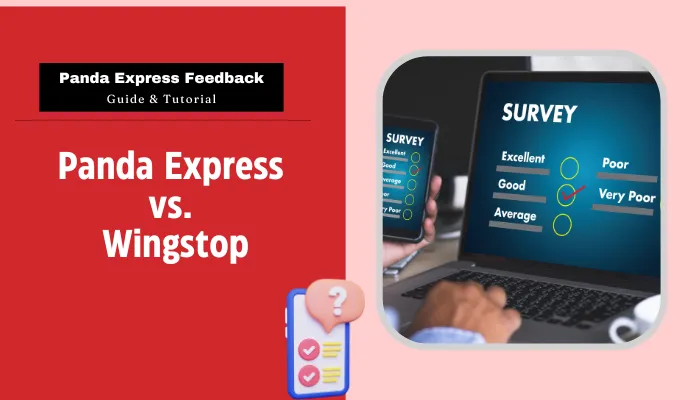Comparing Panda Express vs. Wingstop, one might realize that both provide distinct experiences catering to particular tastes. While the faster service and better quality of ethnicity runner up is Panda Express, Wingstop has been able to establish a passionate consumer base with its interesting chicken wings.

This article will guide you through Panda Express feedback, their origins, menu offerings, pricing, and more to help you decide which of the two satisfies your taste buds better.

What Are the Origins of Panda Express and Wingstop?
The origins of Panda Express vs. Wingstop highlight their distinct paths to becoming fast-casual powerhouses.
Panda Express
Panda Express, American fast food restaurant company was started by Andrew and Peggy Cherng in 1983 after they tried good sales in their Chinese restaurant chain, Panda Inn. The very first outlet of the fast food chain shopping center, Panda Express, was established in California’s Glendale Galleria which is the largest in the fast-casual segment.
The children put it in such a way—Chinese-American food for everyone—with a twist on speed and service that was still fresh from a sit-down restaurant for their customers. All these years bear witnesses to the growth of Panda Express chains across America, other territories as well as international airports, malls, and free-standing spots.
Wingstop
Wingstop’s history dates back to 1994, when Antonio Swad founded the first location in Garland, Texas. The concept was simple yet inventive: focus on one item—chicken wings—and perfect it like no other. The chain’s dedication to wings, fries, and sides quickly found its audience, leading to rapid expansion through franchising.
In 2002, Wingstop would sell its billionth wing, and they must have started to feel popular already. The public proved favorable toward the undertaking: In 2015, the company went public, which accelerated the growth northwards and overseas.
The chains, however, have had their own growth remarkably recently, each of them establishing a steady market through their different concepts and foods.
Menu Offerings
When it comes to satisfying cravings, the menu offerings in the Panda Express vs. Wingstop debate highlight their unique culinary focuses, providing a diverse range of options for every taste.
Panda Express
Panda Express’s menu is a celebration of Chinese-American cuisine, offering a variety of dishes that cater to different tastes and dietary preferences:
- Entrees: Well known meals of Orange Chicken, Beijing Beef, and Kung Pao Chicken remain Wonder’s specialty.
- Sides: Chow Mein, Fried Rice and Super Greens are added to already attractive entrees and provide alternatives.
- Appetizers: During this period, egg rolls and cream cheese rangoons complete this course.
- Healthier Options: But, at least these people can eat reasonably healthy with grilled teriyaki chicken and string bean chicken breast.
Panda Express uses a construct your own plate strategy where patrons have alternatives on which entrees and sides to include in the meal. It is one of the reasons it is appreciated since there are no restrictions on how the clients can want the meals prepared.
Wingstop
Wingstop’s menu is laser-focused on chicken wings, offering them in various flavors and styles:
- Wing Types: Classic (bone-in), Boneless, and Crispy Tenders.
- Flavors: A wide range of sauces and dry rubs, from classic Buffalo to unique options like Mango Habanero and Lemon Pepper.
- Sides: Famous seasoned fries, veggie sticks, and dips complement the wings.
- Add-ons: Rolls and drinks round out the menu.
Wingstop’s strength lies in its specialization. By focusing primarily on wings, the chain has perfected its core offering while still providing enough variety through its flavor options to keep customers coming back.
Ultimately, whether you’re in the mood for Chinese-American comfort food or flavorful wings, both Panda Express and Wingstop offer menu options that satisfy a variety of cravings.
Pricing and Value Proposition
In the fast-casual industry, a comparison between Panda Express vs. Wingstop reveals that while both brands cater to different consumer objectives, they maintain similar pricing within the marketplace.
| Category | Panda Express | Wingstop |
|---|---|---|
| Combo Meals | Offers a balanced variety of entrees and sides starting around $9-$11. | Includes wings, fries, and drink combos starting around $10-$12. |
| Family Meals | Bundled meals for larger groups, priced around $30-$40. | Group packs available, priced around $20-$50 depending on size. |
| A la Carte Options | Allows for individual portions of entrees and sides, prices range from $4-$6 per item. | Wing bundles and individual sides priced between $3-$6 per item. |
| Specialized Offerings | Health-conscious options (like Super Greens), no extra cost for healthier items. | Unique wing flavors, pricing varies based on market conditions. |
| Value Proposition | Sit-down restaurant quality at fast-food speed and pricing. | Focuses on wings and flavor variety, with competitive pricing. |
The pricing strategies of Panda Express and Wingstop are reasonable and suit the type of menus they offer to consumers.
Restaurant Atmosphere and Dining Experience
The atmosphere and dining experience at Panda Express and Wingstop reflect their distinct concepts, catering to different preferences and dining styles.
Panda Express
Panda Express locations are designed to facilitate quick service while still providing a pleasant dining environment:
- Decor: Modern Asian-inspired elements create a clean, bright atmosphere.
- Service Model: Counter service with food displayed behind glass, allowing customers to see options before ordering.
- Seating: Most locations offer dine-in seating, though many customers opt for takeout or drive-thru where available.
- Speed: Emphasizes quick service, with most orders prepared within minutes.
The overall experience at Panda Express is geared towards efficiency and accessibility, making it a popular choice for quick lunches or convenient dinners.
Wingstop
Wingstop’s atmosphere is more akin to a sports bar, albeit in a fast-casual setting:
- Decor: Elements inspired by aviation (around the ‘wing’ theme) coupled with sports themes.
- Service Model: Walk in service, food served is made on demand.
- Seating: In-house dining is allowed, however, most outlets tend towards take-away and home delivery.
- Wait Times: A little longer than Panda Express because food is prepared as per the customer’s request but still under fast-casual expectations.
Its desire is to ensure a relaxed sporty ambience where patrons can comfortably watch a sports event and at the same time savor a meal quickly with their friends.
While Panda Express and Wingstop appear to offer fast food at their respective restaurants, the first focuses on not making oneself wait too long for a meal and it is about the second that makes it very comfortable to eat wings with friends.
Market Positioning and Target Audience
The market positioning and target audience in the Panda Express vs. Wingstop comparison highlight the unique identities of both brands within the fast-casual dining landscape.
Panda Express
Panda Express has positioned itself as the go-to option for Chinese-American fast-casual dining. Its target audience includes:
- Families looking for a crowd-pleasing, affordable dining option.
- Busy professionals seeking quick, satisfying lunches or dinners.
- Mall shoppers and travelers (due to its presence in shopping centers and airports).
- Those seeking a healthier alternative to traditional fast food.
The chain’s broad appeal and widespread presence have made it a familiar and comfortable choice for many Americans.
Wingstop
Wingstop’s market position is more niche, focusing on wing enthusiasts and those seeking a specific flavor experience. Its target audience includes:
- Sports fans looking for game-day eats.
- Young adults and college students drawn to bold flavors and casual dining.
- Families and groups seeking shareable meals.
- Flavor adventurers interested in trying unique wing sauces and rubs.
By specializing in wings, Wingstop has cultivated a dedicated following among those who prioritize this particular dish.
Ultimately, Panda Express and Wingstop target distinct audiences, with Panda Express appealing to a wider demographic and Wingstop focusing on those who crave a unique and flavorful wing experience.
Conclusion
Panda Express vs. Wingstop contrasts the two opposing sides of the fast-casual dining experience. The main emphasis of why for example, Panda has ubiquitous restaurants is due to the wide range of quick and cheap American-Chinese san, which suits many people.
On the other side, Wingstop is a place where one can only find tasty chicken wings. Because of this business, people buy chicken wings, particularly in a niche where chicken wings are sold in abundance and have different flavors. Similarly, both chains today undergo growth and changes, so they are still capable of healthy growth in the competitive nature of dining.
